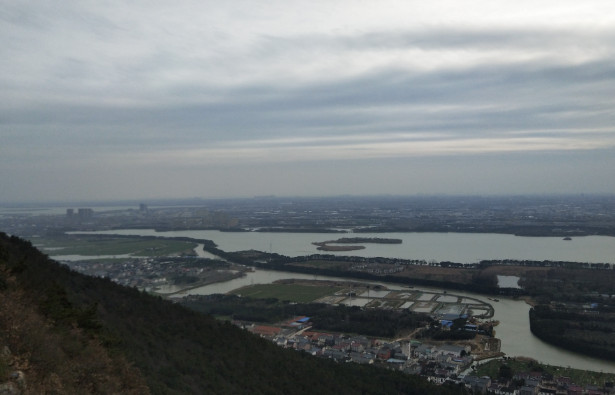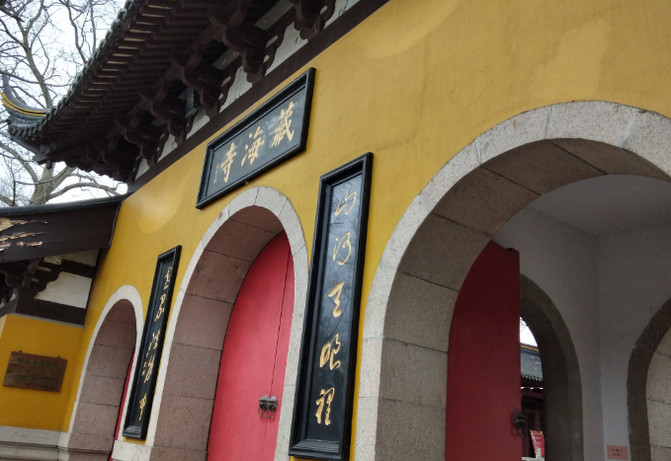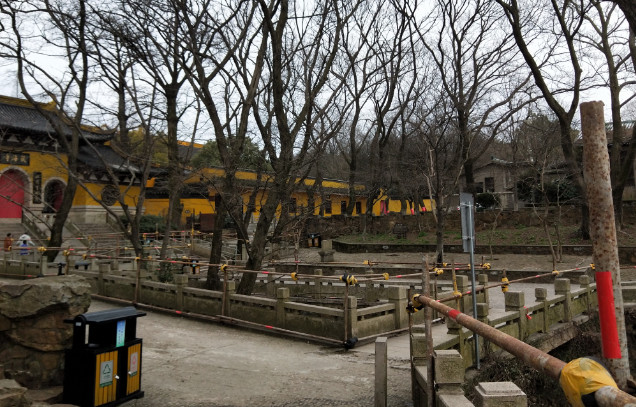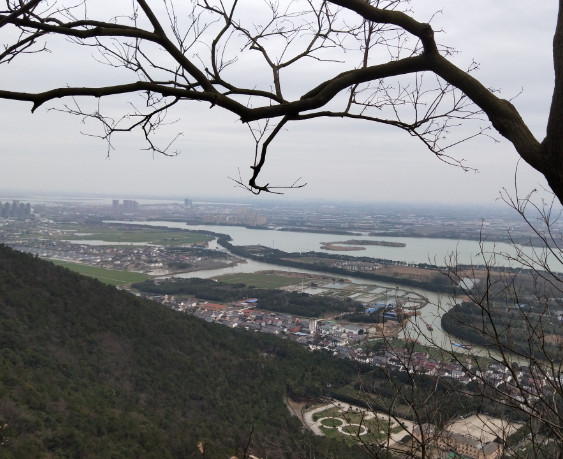Yushan Sword Gate, a scenic spot where Fuchai's furious sword struck
★ Tourist location: Jianmen, Changshu, Suzhou
Baoyan and Jianmen are actually the same scenic spot, and there is a connection between them by Baoyan Sword Dao. It was just that we walked from Baoyan to Shidong Lengquan and came out, so after stopping the bus this time, we took a bus directly to Jianmen Station.

Yushan Sword Gate is the highest point in the middle of Yushan Mountain, with an altitude of 261 meters and is famous for its stone scenery. Sword Gate is of course related to swords. In the Spring and Autumn Annals of Wu Yue, it is said that Gan Jiang, a famous sword blacksmith of Wu, was ordered to forge swords for King Helu of Wu. He collected the iron essence of the five mountains and the six directions of gold and silver in one furnace to cast the Yin and Yang swords. The Yang is named Gan Jiang and the Yin is named Moxie. He presented Moxie to the King of Wu, but hid the generals.

Hiding a sword was of course a serious crime. When He Lu learned about it, he was furious and killed the cadre general with one sword. After the death of Helu, Fuchai ascended the throne. He learned that Gan Jiang had said that "the place where the male sword is hidden, the pine tree grows on the stone", so he chose the place where the pine tree grows on the stone to look for it. When I found the top of the brocade peak of Yushan Mountain, I climbed the rocks with strange pine trees. I heard the faint sound of Moxie wearing on my waist in the sword box. It was the sound of the Yin and Yang swords echoing each other, so I ordered my subordinates to search thoroughly. Hundreds of soldiers searched for three days and three nights, but they never found the male sword. In their anger, they drew out the Moye Sword and faced the dangerous cliff. For a while, lightning flashed and thunder roared, and the dangerous cliff of Jinfeng burst into two. As a result, this place became the famous scenic spot Yushan Sword Gate, so we can see this scenic spot thanks to Fu Chai's temporary anger!

The cracked Sword Gate really has the potential to dominate the pass by ten thousand people. Because the cliffs are quite high, it looks like a military location.

On the left side of the gate is the majestic Sword Pavilion. It was built by Qian Ji, the censor and a local citizen during the Jiajing period of the Ming Dynasty. However, it was later destroyed. It was probably destroyed by the war. The destructive power of the war was really too great. In 1934, a stone pavilion was built to the west of the original site, which can be regarded as an embellishment. The Sword Pavilion we see now was rebuilt in 1988. There are two floors above the top of Xieshan Mountain. Each floor has eighteen long windows, thirty and a half windows, and there is also a corridor on the upper floor.

Walking into the Sword Pavilion, there is a Yushan landscape painting in the hall, with the inscription on it reading "Southeast of Lingshan". In the glass cabinet in the middle is a model of Yushan, which is very majestic.

A peony exhibition is held every year in Jianmen. Unfortunately, it is still early and it is not yet the season when peonies are in full bloom. However, at least a few pots were placed to match the scene, and the variety was relatively single.

Climb to the second floor and look far into the distance, you can see the whole picture of Shanghu and the scenery of the land of fish and rice in the south of the Yangtze River. There are residential houses everywhere and green spaces. Shanghu is the pearl of this land.

Zanghai Temple was built in the Song Dynasty and was initially named Juehai Temple. In the Ming Dynasty, because the location of the temple was on the east side of Fushui Rock, it was renamed Fushui East Temple. During the Shunzhi period of the early Qing Dynasty, it was renamed Zanghai Temple and is still in use today. In the long historical years, this nunnery has also been repeatedly built and demolished. It was destroyed by war during the Xianfeng period, gradually recovered during the Tongzhi period, and was completely destroyed during the Cultural Revolution. It was rebuilt from 1992 to 1997. It lasted five years and is currently the highest temple in Changshu.

In the early Qing Dynasty, Yu Lin, the "Dajue Puji Nengren National Teacher", once visited Yushan. Please be the host and renamed it Canghai Zen Temple. Yu Lin's mother Miao was also a monk and was called the old man Daci. In the 16th year of Shunzhi, Yu Lin was ordered to return to the mountain and gave her mother gold to bury her, built the Daci Pagoda behind the Hall of Great Sorrows, and wrote her own diary of building the pagoda. At that time, Jin Zhijun, the minister of the Ministry of Civil Affairs, wrote a stele, and later Weng Tonghe wrote a couplet for it: "The Wild Crane, the Lonely Cloud Daci Pagoda, the Ancient East Nunnery of Bamboo and Trees."

Walking into the mountain gate, you will see the circulation area on the right side, the Puguang Hall in front of you, and the seating hall and the guest hall on both sides. Puguangming Hall is the main hall of the temple and houses a jade-colored Bodhisattva. I originally thought that the Puguang Light Hall enshrined the Three Saints of Hua Yan, but the three statues were obviously divided into primary and secondary categories. They were probably the statue of Sakyamuni, the founder of Buddhism. What is enshrined behind it is a statue of Guanyin, with its entire body made of gold and a red cloak. It holds a clean bottle in one hand and a Buddhist seal in the other. The boys on both sides were also wearing red capes and clasped their hands together.

On the left side of Puguangming Hall is the Zhenwu Hall, which is dedicated to the Great Emperor Zhenwu. He is covered in plastic gold and wears a yellow cloak. He sits in a Buddhist shrine. On both sides are gods from all walks of life.
On the right is the Hall of Great Compassion. The Hall of Great Compassion enshrines the thousand-handed Guanyin. The whole body is made of gold and the treasure is solemn. The lotus lanterns on both sides are dazzling and eye-catching. They are very beautifully made, which shows that there are many sacrifices.

There is a small hall behind it, dedicated to a certain Dharma King. Judging from the introduction, it seems that he is the Taisui God, and a Taisui Dharma Conference was held here. However, there should be more than one Taisui God corresponding to sixty years. Maybe this is the one on duty.

There is Yu Linwen Room behind, which may be the former abbot's Room. Walking to the end is the Sutra Building, next to it is the door of the National Guard Courtyard. It seems that it should be a side door and cannot pass through the door.

There is a Xianghua Bridge in front of Zanghai Temple. This single-hole stone bridge was built during the Guangxu period of the Qing Dynasty. It spans the Fushui Stream. It has a height of 1.6 meters, a width of 3.25 meters, and a total length of 8.5 meters. The bright pillars on both sides are engraved with a couplet.

There is Changshou Bridge next to it, not far away from Xianghua Bridge and is also built on the stream. On one side is the Changshou Tea Room, but it is not open today.
Changshou Bridge and Xianghua Bridge are erected on the cliff in a T-shape. This is Fushui Rock, a famous scenic spot in Jianmen. It is a cliff several feet high on one side of Jinfeng, very steep. The cliff is facing the lake surface of Shanghu. When the southwest wind blows in summer, when the waterfall pours, the water will stir up when it is lifted up by the strong wind rushing up the hillside. It will rush back into the gap, and people standing on the bridge will feel the drizzle on their faces.

Songfeng Pavilion is located on the top of the peak and the rock. It is a square stone pavilion. The pavilion's forehead was written by the famous painter Zhu Qizhan. On the pavilion pillars are couplets written by the famous painter Xie Zhiliu: "The giant watchtower runs east to the clouds, walks towards the clear rocks, blows the water back to the west", which is about the beautiful scenery of the clear rocks.

Looking into the distance in front of the pavilion, you can see the mighty Yangtze River and the wide Shanghu Lake. The peaks of Yushan Mountain are stacked on top of each other. Although I clearly know that the mountains are not very high, I can see the majestic feeling. As for the name of the Pine Wind Pavilion, it came from the couplet of the tomb stone of the national hero Qu-style Si: "The wind in the ancient stream returns to the thousands of ravines, and the shadows of the cold pool fall on the thousands of pine branches." However, we walked around twice and didn't find the Qu tomb that was said to be nearby.















Previous Article:This old street in Suzhou is very Jiangnan. It is the new favorite of Internet celebrities to check in and has no commercial flavor.
Next Article:Carved buildings, low-key luxury (Part 1)-Suzhou 3 (4)
